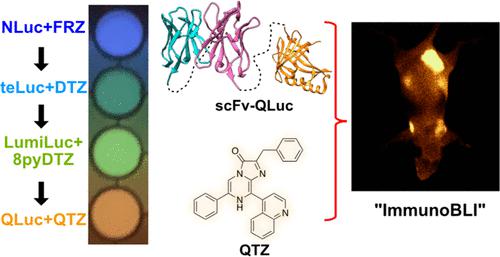当前位置:
X-MOL 学术
›
J. Am. Chem. Soc.
›
论文详情
Our official English website, www.x-mol.net, welcomes your
feedback! (Note: you will need to create a separate account there.)
Engineered Amber-Emitting Nano Luciferase and Its Use for Immunobioluminescence Imaging In Vivo
Journal of the American Chemical Society ( IF 14.4 ) Pub Date : 2022-08-01 , DOI: 10.1021/jacs.2c02320 Ying Xiong 1, 2 , Yiyu Zhang 1, 2 , Zefan Li 1, 2 , Md Shamim Reza 1, 2 , Xinyu Li 1, 2 , Xiaodong Tian 1, 2 , Hui-Wang Ai 1, 2, 3
Journal of the American Chemical Society ( IF 14.4 ) Pub Date : 2022-08-01 , DOI: 10.1021/jacs.2c02320 Ying Xiong 1, 2 , Yiyu Zhang 1, 2 , Zefan Li 1, 2 , Md Shamim Reza 1, 2 , Xinyu Li 1, 2 , Xiaodong Tian 1, 2 , Hui-Wang Ai 1, 2, 3
Affiliation

|
The NanoLuc luciferase (NLuc) and its furimazine (FRZ) substrate have revolutionized bioluminescence (BL) assays and imaging. However, the use of the NLuc–FRZ luciferase–luciferin pair for mammalian tissue imaging is hindered by the low tissue penetration of the emitting blue photons. Here, we present the development of an NLuc mutant, QLuc, which catalyzes the oxidation of a synthetic QTZ luciferin for bright and red-shifted emission peaking at ∼585 nm. Compared to other small single-domain NLuc mutants, this amber-light-emitting luciferase exhibited improved performance for imaging deep-tissue targets in live mice. Leveraging this novel bioluminescent reporter, we further pursued in vivo immunobioluminescence imaging (immunoBLI), which used a fusion protein of a single-chain variable antibody fragment (scFv) and QLuc for molecular imaging of tumor-associated antigens in a xenograft mouse model. As one of the most red-shifted NLuc variants, we expect QLuc to find broad applications in noninvasive mammalian imaging. Moreover, the immunoBLI method complements immunofluorescence imaging and immuno-positron emission tomography (immunoPET), serving as a convenient and nonradioactive molecular imaging tool for animal models in basic and preclinical research.
中文翻译:

工程琥珀色发射纳米荧光素酶及其在体内免疫生物发光成像中的应用
NanoLuc 荧光素酶 (NLuc) 及其呋喃嗪 (FRZ) 底物彻底改变了生物发光 (BL) 测定和成像。然而,NLuc-FRZ 荧光素酶-荧光素对在哺乳动物组织成像中的使用受到发射蓝色光子的低组织穿透性的阻碍。在这里,我们展示了 NLuc 突变体 QLuc 的开发,它催化合成 QTZ 荧光素的氧化,产生明亮的红移发射峰,峰值在 585 nm 处。与其他小型单域 NLuc 突变体相比,这种发出琥珀色光的荧光素酶在活体小鼠的深层组织目标成像方面表现出改进的性能。利用这种新型生物发光报告基因,我们进一步研究了体内免疫生物发光成像(immunoBLI),它使用单链可变抗体片段(scFv)和QLuc的融合蛋白在异种移植小鼠模型中对肿瘤相关抗原进行分子成像。作为红移最大的 NLuc 变体之一,我们期望 QLuc 在非侵入性哺乳动物成像中找到广泛的应用。此外,immunoBLI方法补充了免疫荧光成像和免疫正电子发射断层扫描(immunoPET),为基础和临床前研究中的动物模型提供了一种方便且非放射性的分子成像工具。
更新日期:2022-08-01
中文翻译:

工程琥珀色发射纳米荧光素酶及其在体内免疫生物发光成像中的应用
NanoLuc 荧光素酶 (NLuc) 及其呋喃嗪 (FRZ) 底物彻底改变了生物发光 (BL) 测定和成像。然而,NLuc-FRZ 荧光素酶-荧光素对在哺乳动物组织成像中的使用受到发射蓝色光子的低组织穿透性的阻碍。在这里,我们展示了 NLuc 突变体 QLuc 的开发,它催化合成 QTZ 荧光素的氧化,产生明亮的红移发射峰,峰值在 585 nm 处。与其他小型单域 NLuc 突变体相比,这种发出琥珀色光的荧光素酶在活体小鼠的深层组织目标成像方面表现出改进的性能。利用这种新型生物发光报告基因,我们进一步研究了体内免疫生物发光成像(immunoBLI),它使用单链可变抗体片段(scFv)和QLuc的融合蛋白在异种移植小鼠模型中对肿瘤相关抗原进行分子成像。作为红移最大的 NLuc 变体之一,我们期望 QLuc 在非侵入性哺乳动物成像中找到广泛的应用。此外,immunoBLI方法补充了免疫荧光成像和免疫正电子发射断层扫描(immunoPET),为基础和临床前研究中的动物模型提供了一种方便且非放射性的分子成像工具。











































 京公网安备 11010802027423号
京公网安备 11010802027423号